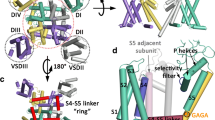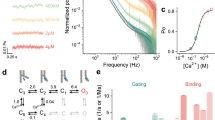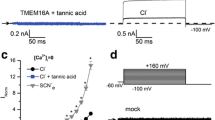Abstract
We explored the ability of a two-site, three-barrier (2S3B) Eyring model to describe recently reported data on current flow through open CaV3.1 T-type calcium channels, varying Ca2+ and Ba2+ over a wide range (100 nm–110 mm) while recording whole-cell currents over a wide voltage range (−150 mV to +100 mV) from channels stably expressed in HEK 293 cells. Effects on permeation were isolated using instantaneous current–voltage relationships (IIV) after strong, brief depolarizations to activate channels with minimal inactivation. Most experimental results were reproduced by a 2S3B model. The model described the IIV relationships, apparent affinities for permeation and block for Ca2+ and Ba2+, and shifts in reversal potential between Ca2+ and Ba2+. The fit to block by 1 mm \( {\text{Mg}}^{2+}_{\text{i}} \) was reasonable, but block by \( {\text{Mg}}^{2+}_{\text{o}} \) was described less well. Surprisingly, fits were comparable with strong ion–ion repulsion, with no repulsion, or with intermediate values. With weak repulsion, there was a single high-affinity site, with a low-affinity site near the cytoplasmic side of the pore. With strong repulsion, the net charge of ions in the pore was near +2 over a relatively wide range of concentration and voltage, suggesting a knockoff mechanism. With strong repulsion, Ba2+ preferred the inner site, while Ca2+ preferred the outer site, potentially explaining faster entry of Ni2+ and other pore blockers when Ba2+ is the charge carrier.








Similar content being viewed by others
References
Almers W, McCleskey EW (1984) Non-selective conductance in calcium channels of frog muscle: calcium selectivity in a single-file pore. J Physiol 353:585–608
Almers W, McCleskey EW, Palade PT (1984) A non-selective cation conductance in frog muscle membrane blocked by micromolar external calcium ions. J Physiol 353:565–583
Andersen OS (1999) Graphic representation of the results of kinetic analyses [editorial]. J Gen Physiol 114:589–590
Bergling S (1999) Which model is best? Let the data decide. J Gen Physiol 114:591
Bittner KC, Hanck DA (2008) The relationship between single channel and whole cell conductance in the T-type Ca2+ channel CaV3.1. Biophys J 95:931–941
Boda D, Valisko M, Eisenberg B, Nonner W, Henderson D, Gillespie D (2006) The effect of protein dielectric coefficient on the ionic selectivity of a calcium channel. J Chem Phys 125:34901
Boda D, Valisko M, Henderson D, Eisenberg B, Gillespie D, Nonner W (2009) Ionic selectivity in L-type calcium channels by electrostatics and hard-core repulsion. J Gen Physiol 133:497–509
Chow CC, White JA (1996) Spontaneous action potentials due to channel fluctuations. Biophys J 71:3013–3021
Dang TX, McCleskey EW (1998) Ion channel selectivity through stepwise changes in binding affinity. J Gen Physiol 111:185–193
Gillespie DT (1977) Exact stochastic simulation of coupled chemical reactions. J Phys Chem 81:2340–2361
Hess P, Tsien RW (1984) Mechanism of ion permeation through calcium channels. Nature 309:453–456
Hodgkin AL, Huxley AF (1952) The components of membrane conductance in the giant axon of Loligo. J Physiol 116:473–496
Khan N, Gray IP, Obejero-Paz CA, Jones SW (2008) Permeation and gating in CaV3.1 (α1G) T-type calcium channels effects of Ca2+, Ba2+, Mg2+, and Na+. J Gen Physiol 132:223–238
Kuo CC, Hess P (1992) A functional view of the entrances of L-type Ca2+ channels: estimates of the size and surface potential at the pore mouths. Neuron 9:515–526
Levitt DG (1986) Interpretation of biological ion channel flux data—reaction-rate versus continuum theory. Annu Rev Biophys Biophys Chem 15:29–57
Lux HD, Carbone E, Zucker H (1990) Na+ currents through low-voltage-activated Ca2+ channels of chick sensory neurones: block by external Ca2+ and Mg2+. J Physiol 430:159–188
McCleskey EW (1999) Calcium channel permeation: a field in flux. J Gen Physiol 113:765–772
McCleskey EW, Almers W (1985) The Ca channel in skeletal muscle is a large pore. Proc Natl Acad Sci USA 82:7149–7153
Nonner W, Eisenberg B (1998) Ion permeation and glutamate residues linked by Poisson-Nernst-Planck theory in L-type calcium channels. Biophys J 75:1287–1305
Nonner W, Chen DP, Eisenberg B (1999) Progress and prospects in permeation. J Gen Physiol 113:773–782
Nonner W, Catacuzzeno L, Eisenberg B (2000) Binding and selectivity in L-type calcium channels: a mean spherical approximation. Biophys J 79:1976–1992
Obejero-Paz CA, Gray IP, Jones SW (2004) Y3+ block demonstrates an intracellular activation gate for the α1G T-type Ca2+ channel. J Gen Physiol 124:631–640
Obejero-Paz CA, Gray IP, Jones SW (2008) Ni2+ block of CaV3.1 (α1G) T-type calcium channels. J Gen Physiol 132:239–250
Perez-Reyes E, Cribbs LL, Daud A, Lacerda AE, Barclay J, Williamson MP, Fox M, Rees M, Lee JH (1998) Molecular characterization of a neuronal low-voltage-activated T-type calcium channel. Nature 391:896–900
Serrano JR, Dashti SR, Perez-Reyes E, Jones SW (2000) Mg2+ block unmasks Ca2+/Ba2+ selectivity of α1G T-type calcium channels. Biophys J 79:3052–3062
Woodhull AM (1973) Ionic blockage of sodium channels in nerve. J Gen Physiol 61:687–708
Yamashita N, Ciani S, Hagiwara S (1990) Effects of internal Na+ on the Ca channel outward current in mouse neoplastic B lymphocytes. J Gen Physiol 96:559–579
Yang J, Ellinor PT, Sather WA, Zhang JF, Tsien RW (1993) Molecular determinants of Ca2+ selectivity and ion permeation in L-type Ca2+ channels. Nature 366:158–161
Yue DT, Marban E (1990) Permeation in the dihydropyridine-sensitive calcium channel. Multi-ion occupancy but no anomalous mole-fraction effect between Ba2+ and Ca2+. J Gen Physiol 95:911–939
Acknowledgments
This work was supported by National Institutes of Health grant NS24771 to S.W. Jones.
Author information
Authors and Affiliations
Corresponding author
Electronic supplementary material
Below is the link to the electronic supplementary material.
Rights and permissions
About this article
Cite this article
Lopin, K.V., Obejero-Paz, C.A. & Jones, S.W. Evaluation of a Two-Site, Three-Barrier Model for Permeation in CaV3.1 (α1G) T-Type Calcium Channels: Ca2+, Ba2+, Mg2+, and Na+ . J Membrane Biol 235, 131–143 (2010). https://doi.org/10.1007/s00232-010-9264-3
Received:
Accepted:
Published:
Issue Date:
DOI: https://doi.org/10.1007/s00232-010-9264-3




